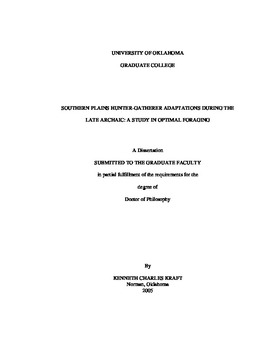| dc.contributor.advisor | Vehik, Susan, | en_US |
| dc.contributor.author | Kraft, Kenneth Charles. | en_US |
| dc.date.accessioned | 2013-08-16T12:19:59Z | |
| dc.date.available | 2013-08-16T12:19:59Z | |
| dc.date.issued | 2005 | en_US |
| dc.identifier.uri | https://hdl.handle.net/11244/954 | |
| dc.description.abstract | In this study, optimal foraging theory is used to evaluate hunting and butchering practices as well as the residence patterns of Late Archaic hunter-gatherers from the southern Plains. Their behavior is represented in the archaeological record by sites, features, and artifacts. Prior to exploring the data, the tenants of optimal foraging theory and central-place foraging, are presented. The first aspect of central-place foraging is that a group will venture from a home base to acquire resources. The second aspect of the theory states that special task groups are used to acquire the said resources. Once located, the resources were returned to the base. In order to better explain the task group aspect of the equation, the group foraging size theorem is employed. The theorem states that the task group's success is contingent on the appropriate number of individuals being available coupled with the appropriate resource placement on the landscape. To check the validity of this argument, two test implications are formulated using the above theoretical constructs. Test #1 is used for Beaver Dam (reliance on a home base) whereas Test #2 is applied to L. E. Certain (employment of a resource encounter and exploitation site). Initially, I set forth the expectations. Then, utilizing the evidence found at the sites, the implications are discussed. Beaver Dam, the base camp, is discussed first since this is where forays into the surrounding biomes originate. This discussion is followed by an assessment of L. E. Certain, a special extractive camp. The data revealed that Late Archaic groups maximized net energy intake while reducing energy expenditure by using a base of operation, that base being situated in an area where multiple resources were gathered just a short distance from camp. When a resource was abundant and some distance from camp, the strategy was to harvest the resource using a specially qualified group. In this study, the groups were bison hunting taskforces. These hunters embarked on their mission with a set of highly specialized stone tools to kill and process the game. The bison meat was procured utilizing butchering techniques that produced large amounts of meat and other byproducts quickly. While some of the meat was eaten on-site, most was dried and returned to camp. That this response was successful is indicated by the fact that large-scale bison kills were conducted at the L. E. Certain site for over 500 years. | en_US |
| dc.format.extent | xx, 438 leaves : | en_US |
| dc.subject | Beaver Dam Site (Okla.) | en_US |
| dc.subject | History, United States. | en_US |
| dc.subject | Animal remains (Archaeology) Oklahoma. | en_US |
| dc.subject | Excavations (Archaeology) Oklahoma Roger Mills County. | en_US |
| dc.subject | L. E. Certain Site (Okla.) | en_US |
| dc.subject | Anthropology, Archaeology. | en_US |
| dc.subject | Roger Mills County (Okla.) Antiquities. | en_US |
| dc.subject | Excavations (Archaeology) Oklahoma Beckham County. | en_US |
| dc.subject | American bison hunting Oklahoma. | en_US |
| dc.subject | Beckham County (Okla.) Antiquities. | en_US |
| dc.subject | Biology, Ecology. | en_US |
| dc.title | Southern Plains hunter-gatherer adaptations during the Late Archaic: A study in optimal foraging. | en_US |
| dc.type | Thesis | en_US |
| dc.thesis.degree | Ph.D. | en_US |
| dc.thesis.degreeDiscipline | Department of Anthropology | en_US |
| dc.note | Source: Dissertation Abstracts International, Volume: 66-12, Section: A, page: 4426. | en_US |
| dc.note | Adviser: Susan Vehik. | en_US |
| ou.identifier | (UMI)AAI3203314 | en_US |
| ou.group | College of Arts and Sciences::Department of Anthropology | |
